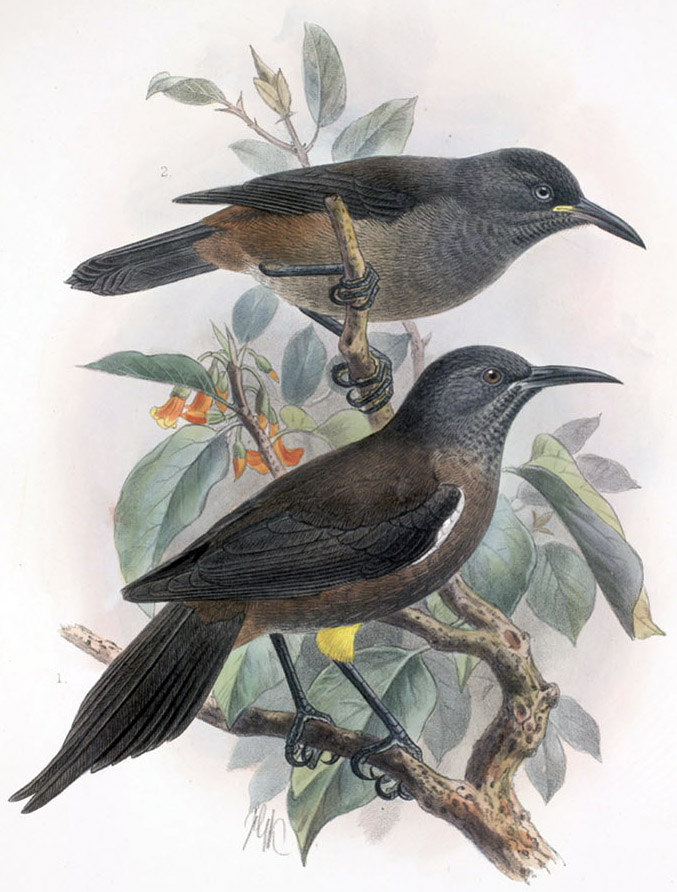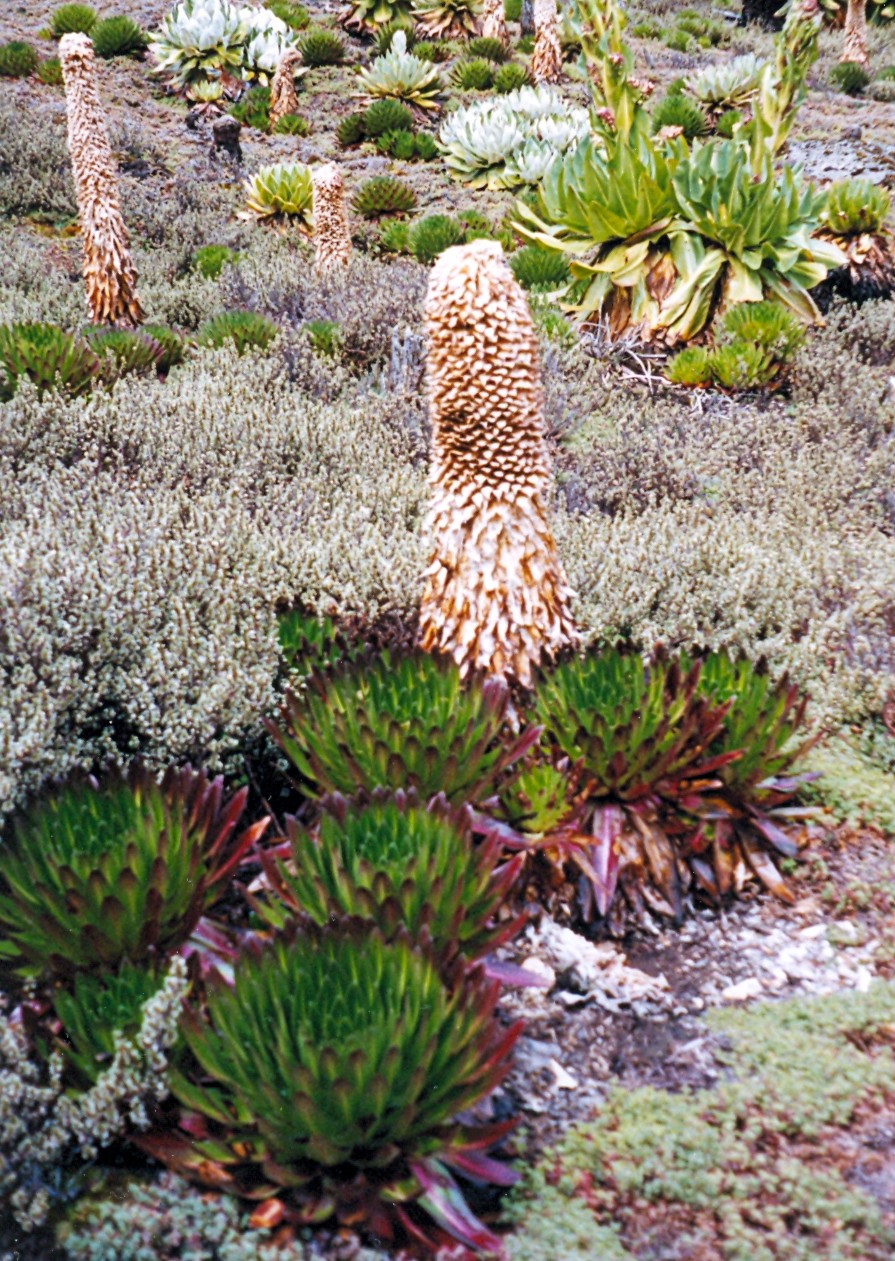
My Lobelias: Delissea rhytiosperma, Cyanea leptostegia, Clermontia kakeana, Brighamia insignis, Brighamia rockii
An island kingdom crumbles into the sea. Refugees flee to a new land. With this new beginning, they prosper once more. Could it be the Atlantean myth? The Mayan-Egyptian pyramid connection? While it sounds like the story of Atlantis, it also describes the natural history of the ‘o’o birds and the Hawaiian lobelias.
I’ve enjoyed imagining about the biota that fled their crumbling kingdom. In my previous post, I mentioned the previous set of islands over the Hawaiian Hotspot before the current Hawaiian islands. How Laysan, Gardner, LaPerouse arose to their greatest extent 18-13 million years ago and then become much reduce by the time the island of Kaua’i formed and the difficulties the biota would have dispersing to this new land. Make no mistake those two elements of the Hawaiian flora and fauna are not the only ones to disperse from the older islands, but they are the ones that have captured my imagination. The ‘o’o birds for their amazing transformation and the lobelias for their spectacular radiation.

Kaua'i 'o'o
There were 4 different species of ‘o’o birds. They are the Kaua’i ‘o’o (Moho braccatus), the Oahu ‘o’o (Moho apicalis), the Bishop’s ‘o’o (Moho bishopi), and the Hawai’i ‘o’o (Moho nobilis). They along with the Kioea (Chaetoptila angustipluma) formed a monophyletic group of nectivorous birds now called mohoidae. They are sadly now all extinct, with the last known Kaua’i ‘o’o last seen in 1987.
For the longest time, biologist had grouped them with Australo-Pacific honeyeaters of the family meliphagidae. But a 2008 paper tells a different tale. When DNA testing was done, the results were surprising. The mohoids closest relatives were not meliphagids, but a clade that compromised of the cedar waxwings and palmchats. The tests showed that they seemed especially close to silky flycatchers. Not only are these birds from the other side of the Pacific, in the Americas, but they are frugivores and insectivores.
To go from a diet of mainly fruits and bugs to one of mostly nectar is quite the

A meliphagid: New Holland Honeyeater
transformation. Mohoids developed enlongated tarsi and strong feet to reach flowers, brush-like tongue to lap up the nectar, an operculum that covered the nares to protect them from pollen, and a decurved bill. They developed these traits to such a degree that they were indistinguishable from the meliphagids.
Mohoids, these flycatchers in nectar-eating clothing, are a perfect example of convergent evolution. Because the islands arose with these niches empty, mohoid ancestors were able to fill them without the competition from others. It must have taken time to make the transformation, and the same researchers estimate that the mohoids diverged from their nearest relatives some 14-17 million years ago. That places them right in the first peak period of the Hawaiian chain with Gardner being the largest island. So far, they are the only vertebrate group that dates to a time before the formation of Kaua’i.
Another clade that is estimated to have diverged from their closest relatives around the same time are the Hawaiian lobeliads, as another paper shows. Its important because the birds had to get nectar from somewhere. Indeed, the lobeliads are the oldest known bird-pollinated flora group in the Hawaiian Islands. The researchers estimate the lobeliads arrived 13 million years ago.
Besides their great age, the lobeliads are noteworthy because of their stunning radiation. At 126 species, the group is the largest plant clade derived from a single colonization found on ANY oceanic island. They have adapted to many different habitats, from open, montane grasslands to wet forest interiors. Some have a succulent stalk (Brighamia), others are monocarps (Trematolobelia). They can grow as branched shrubs (Clermontia) or huge 30 ft trees (Cyanea).

African giant lobelias
It is thought that the ancestral lobelia was a bird-pollinated, wind dispersed plant of open montane habitat. Some of the lobelias nearest relatives have this form in Polynesia and East Africa. To invade the new wet forest interior habitat available to them, lobelias developed fleshy fruit. Which, if you think about it, makes sense; capsular fruit that dehisce so that the wind can take their tiny seeds works well in open windy
environments. But in a forest interior, where it is rainy and there is relatively little wind, its a poor strategy. So, once again, the plant enlisted their avian allies. The plants developed fleshy fruit which the birds would readily eat, thus dispersing the seeds.
This affected lobeliad speciation. The plants reliant on the wind have high dispersal rate; tiny, wind-blown seeds could travel between the islands fairly well. Because the different gene pools on each island were in contact with each other, they had lower rates of speciation. Indeed, in the following genera have a low number of species: Lobelia sect. Galeatella (4 sp.), Trematolobelia (4 sp.), Lobelia sect. Revolutella (9 sp.), Brighamia (2 sp.). They are also found on multiple islands with one, Lobelia hypoleuca, found on most of the main islands.
The plants whose main method of dispersal are the birds are a different story. Many of the forest birds had specific habitat needs and dislike traversing habitat barriers. The seed dispersal by the birds were much lower, allowing for many more populations to become isolated. Thus, the bird dispersed plants have a higher speciation rate, with Cyanea having 76 different species, many found only in certain areas of a single island.
This sort of interaction between bird and plant and the resulting evolution is very cool for me. While we can never be certain, it is still neat to think that mohoids and lobeliads drove each others very interesting story. It offers a glimpse of what might have been occurring in the Hawaiian chain way, way back in the Miocene. Those islands, Gardner in particular, must have had an amazing, diverse biota. But whatever they were, we can only imagine, as the sea reclaimed that land long ago.
Which is why its especially sad for me to see that all the mohoids have gone extinct in the very recent past. I went to a talk given by Jim Jacobi, a famed ornithologist. He was telling the story of the last Kaua’i ‘o’o. In 1985, they were able to get voice recordings of the bird. The bird’s mate had not been seen since Hurricane Iwa a few years earlier. After spending much effort, they finally got close enough to make solid recordings. When the bird finally flew off, Jim and his group replayed what they had just recorded. They wanted to hear the quality of the calls. To their surprise, the bird flew back. It must have thought it was another ‘o’o bird and wanted to investigate. Alas, it wasn’t. That was the last time they saw the bird.
He played the recording when he told us the story. It sent chills up my spine. I can’t really explain the emotions of hearing that voice. That distinct voice with a history that travels all the way back to an ancient long gone island chain was emanating from a tiny hand-held speaker. Its a little overwhelming to think about. While the birds might be gone, their partners in crime, the lobelias are still around. The least we can do is make sure they don’t suffer the same fate.
Links-
Only known video of Kaua’i ‘o’o
Refs-
Fleischer, R.C., James, H.F. and Olson, S.L. 2008. Convergent evolution of Hawaiian and Australo-Pacific honeyeaters from distant songbird ancestors. Current Biology, 18: 1927-1931.
Givnish, T.J., et al. 2008. Origin, adaptive radiation and diversification of the Hawaiian Lobeliads (Asterales: Campanulaceae) Royal Publishing Society
Price, J. P. & Clague D.A. 2002 How old is the Hawaiian Biota? Geology and Phylogeny suggest a recent divergence. Royal Publishing Society




















